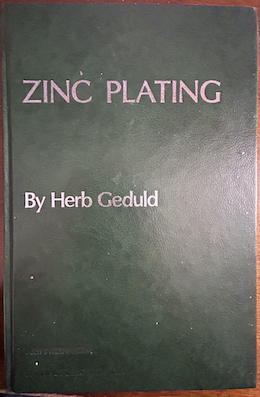
-----
What is Zinc Passivation
Q. I have a customer that calls out zinc passivate as the finish on their cold rolled steel (1018 steel) on a small hat section bracket job. We do a lot of gold, clear and black zinc jobs (through outside process platers) and have never heard of zinc passivate. All of our platers are dumbfounded by this callout and have no idea what it is either. Can anyone help me to understand what this process is and possibly where I could get this done?
Thank you.
- Livermore, California
2002
A. Hi Ken. The process of chromate conversion coating of zinc plated parts is sometimes called "passivation". I'm quite confident that the customer is looking for zinc plating followed by chromate conversion coating, which your plating shops can do.
But when experienced fabricators & metal finishing shops are unfamiliar with a term, and the term is very loose one like "zinc passivate" rather than a particular specification number, it can be a recipe for a contract dispute. As you note, you do gold, clear, and black, whereas this call out doesn't specify which color they want. They probably want clear, but you'd better check :-)

Ted Mooney, P.E.
Striving to live Aloha
finishing.com - Pine Beach, New Jersey
Ted is available for instant help
or longer-term assistance.
A. Zinc plated steel is almost always a bright, silver colored finish. Chromate conversion coatings are applied for increased corrosion resistance. The chromate conversion coatings are available (usually) in blue, yellow, olive drab, black etc. Another name for the chromate conversion coating is passivate.
Vic Waldman- Naugatuck, Connecticut
2002
Q. How to specify the requirement of thickness in a drawing after passivation. Is there any standard based on the need or requirement?
Regards,
Student - Bangalore, Karnataka, India
May 3, 2013
A. Hi, RM. Zinc plating is virtually always chromate conversion coated. In these days of RoHS requirements, you should specify trivalent chromate conversion coating and pick a color (clear, yellow, black). Chromate conversion coating "converts" the zinc to a complex mixture of zinc chromates, chromic oxides, zinc oxides, and related compounds; it's not so much a topcoat as a conversion, so it adds very little if anything to the thickness. One easy way to look at it is that it will add less than the tolerance on your zinc plating thickness ... so you don't have to worry about specifying or making allowance for its thickness. Good luck.
Regards,

Ted Mooney, P.E.
Striving to live Aloha
finishing.com - Pine Beach, New Jersey
Ted is available for instant help
or longer-term assistance.
How thick and dense are chromate conversion coatings? How to measure or calculate?
Q. Thanks for the information about chrome-based conversion coatings.
As an end user we should be able to demonstrate analytically that the parts we use comply with legislation. Hexavalent chromium has proved difficult to quantify in terms of a %w/w content within the conversion layer. If we can measure the thickness and find the density we can use measurements according to ISO 3613
Which brings me to ask: Is there a known value for the density of chromium passivation layers?
Any other guidance on how to measure w/w% hexavalent chromium within these layers would be appreciated too.
Thanks,
Matthew
- Cheshire East, UK
December 5, 2014
A. Perhaps the simplest and most accurate method for determining Cr+6 content in the chromate layer is the test method defined in IEC62321, Annex B. This method is intended to isolate the chromate layer for purposes of RoHS compliance.
Ty Geverink- Glendale, California, USA
August 4, 2015
Q, A, or Comment on THIS thread -or- Start a NEW Thread
